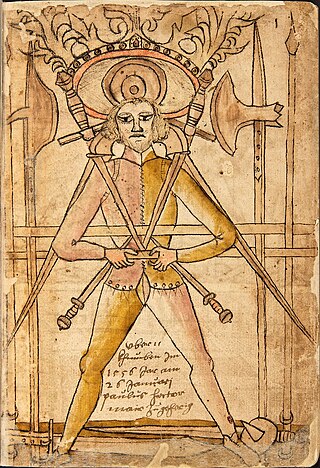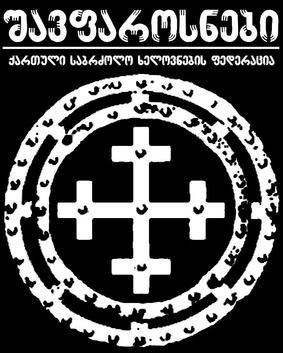History
The Wolf System (under the name "Re:Action") was originally a collection of techniques adapted from professional wrestling, historical fencing, mime and various martial arts styles. Over time, and due in part to the pedagogical influence of the modern dance discipline of contact improvisation and of the Russian martial art of Ryabko Systema, the Wolf System's emphasis shifted from a curriculum of specific techniques to an open-ended progression of largely improvised training games and exercises.
The system was introduced to the international community at the Paddy Crean International Stage Combat Conferences held at the Banff Centre in Alberta, Canada, in 1998. Since then, aspects of the system have been taught to actors, directors, martial artists, dancers, choreographers and stunt performers in New Zealand, Australia, Canada and the US, as well as at master-class seminars in England, Ireland, Norway, the Netherlands, Italy and Germany.
Philosophy and pedagogy
The Wolf System is designed to teach a series of fundamental movement and/or performance skills, which are divided into the following categories:
Synergy - non-verbal, especially tactile responsiveness and communication
Articulation - cycles of preparation, action and reaction in performing stage combat techniques, both for the safety of the performers and for clarity of live or on-camera performance
Illusion - methods of misdirection and of concealing certain safety measures from the audience or camera to preserve the illusion of actual combat
Alignment - methods of skeletal alignment supported by muscular control as used in maintaining balance and in supporting another person's body weight Extension - methods of projecting momentum
Cascade - methods of safely moving from a standing position to the floor by collapsing or rolling
Measure - methods of judging the active distance between oneself and another person
Of the above, both Articulation and Illusion are specific to the use of the Wolf System in stage combat training. The two fundamental premises of the Wolf System in stage combat are defined as Safety and Storytelling, both with reference to performance combat as a skill of theatrical illusion.
Wolf System exercises
Some of the games and exercises may be performed individually while others may be performed in pairs or by groups of up to 20 people.
Participants in this form of training constantly alternate between co-operating and competing with their partner(s) during different exercises. Co-operative games require the participants to work together to achieve a specific result, such as balancing against each other's bodies while in physically awkward positions or keeping their hands in contact while performing various improvised movement exercises. Competitive games require the participants to work against each other, as in contests of balance and speed.
Participants also alternate between moving "in character" and as themselves, between improvised and choreographed exercises and between assuming active and passive roles during the various exercises.
To perform Wolf System exercises with a partner or in a group environment is known as jamming, a term borrowed from contact improvisation and from jazz.
The Wolf System can be used to introduce combative concepts and skills to students who may not have any previous background in fencing, martial arts or related disciplines. Also, the open-ended nature of the exercises allow participants to experiment with a wide range of unusual fighting techniques and styles, including many that are not typically offered in more orthodox stage combat or martial arts training programs.

Martial arts are codified systems and traditions of combat practiced for a number of reasons such as self-defence; military and law enforcement applications; competition; physical, mental, and spiritual development; entertainment; and the preservation of a nation's intangible cultural heritage.

Neijia is the collective name for the internal Chinese martial arts. It relates to those martial arts occupied with spiritual, mental or qi-related aspects, as opposed to an "external" approach focused on physiological aspects. The distinction dates to the 17th century, but its modern application is due to publications by Sun Lutang, dating to the period of 1915 to 1928. Neijing is developed by using neigong or "internal changes", contrasted with waigong or "external exercises".

Taekwondo, also spelled tae kwon do or taekwon-do, is a Korean martial art and combat sport involving punching and kicking techniques. The literal translation for taekwondo is "kicking", "punching", and "the art or way of". It sometimes involves the use of weapons.

Arnis, also known as kali or eskrima/escrima, is the national martial art of the Philippines. These three terms are, sometimes, interchangeable in referring to traditional martial arts of the Philippines, which emphasize weapon-based fighting with sticks, knives, bladed weapons, and various improvised weapons, as well as "open hand" techniques without weapons.

Stage combat, fight craft or fight choreography is a specialised technique in theatre designed to create the illusion of physical combat without causing harm to the performers. It is employed in live stage plays as well as operatic and ballet productions. With the advent of cinema and television the term has widened to also include the choreography of filmed fighting sequences, as opposed to the earlier live performances on stage. It is closely related to the practice of stunts and is a common field of study for actors. Actors famous for their stage fighting skills frequently have backgrounds in dance, gymnastics or martial arts training.

Chinese martial arts, often called by the umbrella terms kung fu, kuoshu or wushu, are multiple fighting styles that have developed over the centuries in Greater China. These fighting styles are often classified according to common traits, identified as "families" of martial arts. Examples of such traits include Shaolinquan (少林拳) physical exercises involving All Other Animals (五形) mimicry or training methods inspired by Old Chinese philosophies, religions and legends. Styles that focus on qi manipulation are called internal, while others that concentrate on improving muscle and cardiovascular fitness are called external. Geographical association, as in northern and southern, is another popular classification method.

Japanese martial arts refers to the variety of martial arts native to the country of Japan. At least three Japanese terms are used interchangeably with the English phrase Japanese martial arts.
The following outline is provided as an overview of and topical guide to martial arts:
Postmodern dance is a 20th century concert dance form that came into popularity in the early 1960s. While the term "postmodern" took on a different meaning when used to describe dance, the dance form did take inspiration from the ideologies of the wider postmodern movement, which "sought to deflate what it saw as overly pretentious and ultimately self-serving modernist views of art and the artist" and was, more generally, a departure from modernist ideals. Lacking stylistic homogeny, Postmodern dance was discerned mainly by its anti-modern dance sentiments rather than by its dance style. The dance form was a reaction to the compositional and presentational constraints of the preceding generation of modern dance, hailing the use of everyday movement as valid performance art and advocating for unconventional methods of dance composition.

Swordsmanship or sword fighting refers to the skills and techniques used in combat and training with any type of sword. The term is modern, and as such was mainly used to refer to smallsword fencing, but by extension it can also be applied to any martial art involving the use of a sword. The formation of the English word "swordsman" is parallel to the Latin word gladiator, a term for the professional fighters who fought against each other and a variety of other foes for the entertainment of spectators in the Roman Empire. The word gladiator itself comes from the Latin word gladius, which is a type of sword.

Historical European martial arts (HEMA) are martial arts of European origin, particularly using arts formerly practised, but having since died out or evolved into very different forms.

Sparring is a form of training common to many combat sports. Although the precise form varies, it is essentially relatively 'free-form' fighting, with enough rules, customs, or agreements to minimize injuries. By extension, argumentative debate is sometimes called sparring.

Hand-to-hand combat is a physical confrontation between two or more persons at short range that does not involve the use of ranged weapons. The phrase "hand-to-hand" sometimes include use of melee weapons such as knives, swords, clubs, spears, axes, or improvised weapons such as entrenching tools. While the term "hand-to-hand combat" originally referred principally to engagements by combatants on the battlefield, it can also refer to any personal physical engagement by two or more people, including law enforcement officers, civilians, and criminals.

The Marine Corps Martial Arts Program is a combat system developed by the United States Marine Corps to combine existing and new hand-to-hand and close quarters combat techniques with morale and team-building functions and instruction in the warrior ethos. The program, which began in 2001, trains Marines in unarmed combat, edged weapons, weapons of opportunity, and rifle and bayonet techniques.

Bartitsu is an eclectic martial art and self-defence method originally developed in England in 1898–1902, combining elements of boxing, jujitsu, cane fighting and French kickboxing (savate). In 1903, it was immortalised by Sir Arthur Conan Doyle, author of the Sherlock Holmes mystery stories. Dormant throughout most of the 20th century, Bartitsu has experienced a revival since 2002.

Combat reenactment is a side of historical reenactment which aims to depict historical forms of combat. This may refer to either single combat, melees involving small groups, or nearly full-scale battles with hundreds of participants.
Association for Renaissance Martial Arts (ARMA) is a US-based non-profit organization dedicated to the study and practice of historical European martial arts of the 15th to 17th centuries.

Although the earliest evidence of martial arts goes back millennia, the true roots are difficult to reconstruct. Inherent patterns of human aggression which inspire practice of mock combat and optimization of serious close combat as cultural universals are doubtlessly inherited from the pre-human stage and were made into an "art" from the earliest emergence of that concept. Indeed, many universals of martial art are fixed by the specifics of human physiology and not dependent on a specific tradition or era.
Italian martial arts include all those unarmed and armed fighting arts popular in Italy between the Bronze age until the 19th century AD. It involved the usage of weapons. Each weapon is the product of a specific historical era. The swords used in Italian martial arts range from the Bronze daggers of the Nuragic times to the gladius of the Roman legionaries to swords which were developed during the renaissance, the baroque era and later. Short blades range from medieval daggers to the liccasapuni Sicilian duelling knife.

The Shavparosnebi (შავფაროსნები) or Blackshields are a Georgian martial arts federation. The head of the Georgian Martial Arts union is Lasha Kobakhidze. Traditional Georgian martial arts has had a revival by the activities of Kobakhidze and his team of enthusiasts. They are known for their combat art performances and are actively involved in the revival of traditional Georgian fighting techniques. The Blackshields are named for historical Georgian partisan fighters, who painted their faces and shields black to engage in guerrilla warfare at night. The founders of the Blackshields began researching Georgian martial arts shortly before the collapse of the Soviet Union. Since then, the group and the subject of traditional fighting styles in general have become increasingly popular. Their training involves the use of daggers, swords, and axes, conducted exclusively outdoors and in all weather conditions. Students also engage in activities such as searching, by night, for items hidden in the forest by their instructors. The Blackshields are an all-male organization comprising some 300–400 members, with studios in most major Georgian cities.














